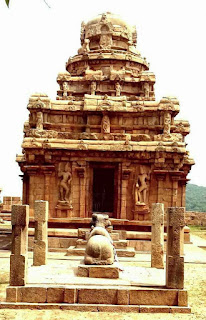Pallavas Contribution To Indian Culture
The stone inscription in Mahabalipuram and Kanchipuram
name the Pallava rules, recounting
their great deeds but not
much light is thrown on their
origin.The inscriptions are in
Prakrit, Sanskrit and Tamil probably
denoting the order in point
of time in which the languages came in
to use. Tamil was made
the official language of the realm by
the Pallavas who are
believed to have come from the north.
Some scholars
consider them kin to the parathions.
The main characteristics, however, as
handed down by
history are undisputed a war light
tradition, which enabled
them to set up a strong kingdom,
ensuring a succession of
Chalukyas and Rashtrakutas in the
north, and the rising Tamil
Princes in the South, and an artistic
temperament, which found
expression in a creative Endeavour that
has earned for Tamil
Nadu a fame as imperishable as the
rocks on which they spent
their skill.
Simhavishun 575 – 600 A.D. is authentic, unlike
those
particulars after often given going
farther back to 350 – 500
A.D. Vassals of the Satavahana empire became independent
early in the 3rd century and expended
their hold over the area
from Kanchipuram to the Krishna. It was
during the time of
Simhavishnu, who, on coming to the
throne assumed the title
of 'Svarishimha', known as 'Lion of the
South that the
Pallavas began the career of conquest
that brought
Cholamandalam under their control.
Among the sculptures at
Mahabalipuram is a relief of this
doughty king with his two
queens. He is also known to have been
the patron of Bairavi,
the Sanskrit poet who was the author of
Kireetarjuniyam.
Mahendravarman -I is also credited with
introducing the
concept of cave temples excavated from
solid rock. Most of
monuments of Mahabalipuram, and
certainly the rathas, are
said to have been carved during his
reign.
saw the creation of the best of the
early Pallava masonry
temples, beginning with the
Kailasanatha temple at
Kanchipuram. He assumed the title of
Rajasimha. He greatly
assisted in his endeavors in the field
of art by his queen
Rangapathaka. Nandivarman, 717 – 719
A.D. was responsible
for the other famous temple at Kanchi,
the Vaikundaperumal
temple.
Few cities rival Kanchi, the home of
Pallava art and the
seat of administration, the wealth of
literary, inscriptional and
sculptural work. The great Buddhist
scholar Dharmapala
belonged to Kanchi so did Vatsyayana,
the author of
Nyayabhasya. The Pallavas were ardent
Hindus and Saivism
and Vaishanava literatures flowered
during their period in what
may be called a great religious
revivalist movement. The
study of Sanskrit and the Vedas under
the influence of Saivism
flourished in Kanchi in what must have
been the final phase of
Sanskrit culture and Aryanaisation of
the South. Outside the
country, under the impetus which their
rule provided, Sanskrit
culture spread far and wide in South
East Asia. Soon after
them, Tamil took over in the Pallava
region under Chola –
Pandya hegemony, and Telugu held sway
under the
Rashtrakutas in the Andhra country to
the north. Indian
history in both the north and the south
entered a new phase.
Archaeological remains of the Pallava
period are found
extensively in the kingdom, but the
finest are in Kanchipuram
and Mahabalipuram. Worker of art so
numerous and
fascinating as those found in
Mahabalipuram could have been
undertaken by a prince of the ruling
dynasty. There are 14
cave temples, nine monolithic shrines,
three structural stone
temples and four bas relief rock
panels.
Scholars specializing Mahabalipuram
have unraveled
some of the mysteries relating to who
why and how. Two views
are prevalent on the origin of the
monuments-one, that they
were commissioned by one king in
particular,
Narasimhavarman - I and the other, it
was Rajasimha known as
Narasimhavarma - II who was solely
responsible for all of them
in the 8th century. Historians have not pronounced
finally on
the authorship and the examination of
the evidence goes on.
Some archeologists have come out with
weighty arguments
against the multiple authorship theory,
declaring that all these
monuments were ordered by Rajasimha.
This kings title,
'Atyantakama', which appear to refer to
his achievement in
creating an "unlimited
variety" of monuments and sculptures.
But it is on this very variety of
styles noted on the work that
the other theory, attributing the
monuments to several rulers,
rests. These variation in style, it
must be pointed out, are not
obvious at first glance.
The Pallava rulers occupy an important
place in the
school on South Indian temple-building
that is famous
throughout the world as Dravidian
style. A product of a
thousand years of evolution, this style
had its faint beginning
in the Pallava period and it was the
Pallava rulers who gave it
direction and impetus. It was on their
foundations that
significant contributions were made
later by the Cholas and
Pandyas. The Pallava rathas were the
core of this style and
this essential element of the temple
complex took root under
Pallava patronage in the structures in
Mahabalipuram and
Kanchipuram. This must have been
proceeded simultaneously
with the declining importance of the
Buddhist and Jain styles in
the region, south of the Krishna river
in Mahabalipuram
itself, three phases of the
architectural development can be
traced corresponding to the periods of
the three eminent
rulers, Mahendra varman,
Narasimhavarman - I and Rajasimha,
reflecting progressive degrees of
refinement that can be
discerned even by the lay man.




Super
ReplyDelete